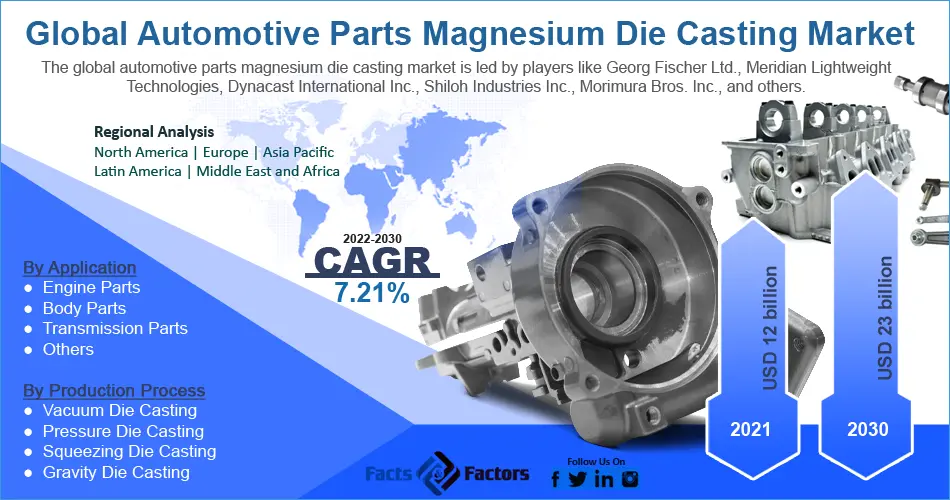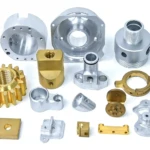Automotive Parts Magnesium Die Casting Market Analysis: A Deep Dive into Growth, Challenges, and Opportunities
The automotive industry is rapidly evolving, with manufacturers constantly seeking ways to improve vehicle performance, reduce weight, and enhance safety. One of the materials that have been gaining significant traction in recent years is magnesium, particularly in the form of magnesium die casting. Magnesium die casting allows automotive manufacturers to produce lightweight, durable, and high-performance parts. As the demand for such parts continues to increase, the automotive parts magnesium die casting market is poised for substantial growth. In this article, we will analyze the current state of the market, explore the key drivers and challenges, and provide insights into emerging opportunities and trends.
Overview of the Automotive Parts Magnesium Die Casting Market
What is Magnesium Die Casting?
Magnesium die casting involves the process of injecting molten magnesium alloy into a steel mold under high pressure. This process is widely used in the production of automotive parts due to magnesium’s unique properties, including its lightweight nature, high strength-to-weight ratio, and good corrosion resistance. The magnesium die casting process is considered one of the most efficient methods for manufacturing complex, thin-walled automotive components with high precision.
Why Magnesium for Automotive Parts?
Magnesium is increasingly being chosen for die casting in the automotive sector because of its combination of lightness and strength. Magnesium alloys are typically 75% lighter than steel, yet they provide comparable or even superior strength. This feature is particularly valuable in the automotive industry, where reducing weight is essential to improve fuel efficiency, decrease emissions, and enhance overall performance. Magnesium also offers excellent dimensional stability, making it ideal for manufacturing components that need to meet strict specifications.
Market Size and Forecast
According to a report by Facts Factors, the global automotive parts magnesium die casting market was valued at approximately US$12 billion in 2021 and is expected to reach US$23 billion by 2030, growing at a compound annual growth rate (CAGR) of 7.21% from 2022 to 2030. This growth is driven by the increasing demand for lightweight materials in the automotive sector and the adoption of magnesium die casting technology to meet these needs.
Key Drivers of Market Growth
The growth of the automotive parts magnesium die casting market is influenced by several factors, each contributing to the increased demand for magnesium alloys and the die casting process in automotive manufacturing.
1. Growing Demand for Lightweight Automotive Parts
Reducing vehicle weight is one of the primary goals for automotive manufacturers. Lighter vehicles lead to better fuel efficiency, lower CO2 emissions, and enhanced overall performance. Magnesium, being the lightest structural metal, is an ideal material for achieving these goals. As the automotive industry shifts towards electric vehicles (EVs) and more fuel-efficient internal combustion engine (ICE) vehicles, the demand for magnesium die casting parts is expected to rise.
2. Improved Mechanical and Chemical Properties of Magnesium Alloys
Magnesium alloys offer an impressive range of mechanical and chemical properties that make them suitable for die casting in the automotive industry. These properties include:
- High strength-to-weight ratio: Magnesium alloys are lightweight yet strong, making them ideal for parts that need to bear stress without adding unnecessary weight.
- Corrosion resistance: Magnesium alloys are more resistant to corrosion compared to other materials like aluminum and steel, making them ideal for automotive parts exposed to various weather conditions.
- Dimensional stability: Magnesium parts can maintain their shape and accuracy over time, which is crucial for parts that need to fit together perfectly in complex assemblies.
3. Technological Advancements in Die Casting Processes
The development of advanced die casting techniques has further fueled the growth of the magnesium die casting market. The shift towards high-pressure die casting (HPDC) and the emergence of vacuum die casting methods have enabled manufacturers to produce high-quality magnesium components with greater efficiency. These technological advancements allow for the production of complex, thin-walled, and lightweight automotive parts with minimal defects.
4. Regulatory Pressure and Environmental Concerns
Governments around the world are imposing stricter regulations on vehicle emissions, pushing automotive manufacturers to focus on lightweight designs and energy-efficient technologies. As the automotive industry moves towards greener alternatives, the need for lightweight materials like magnesium will continue to rise. Magnesium’s ability to contribute to improved fuel efficiency and reduced emissions makes it a key player in the shift toward sustainable mobility.
5. Rising Electric Vehicle Adoption
Electric vehicles (EVs) are becoming increasingly popular due to their environmental benefits and government incentives. EVs typically require lightweight components to improve battery range and efficiency. Magnesium die casting offers an effective solution to meet these needs. With the growth of the electric vehicle market, the demand for magnesium die casting parts is expected to surge, especially in critical automotive components like battery enclosures, chassis, and drivetrain components.
Challenges Facing the Automotive Parts Magnesium Die Casting Market
While the prospects for the automotive parts magnesium die casting market are promising, there are several challenges that market players must overcome.
1. Casting Defects and Quality Control
One of the significant challenges in magnesium die casting is managing casting defects such as cold shuts, undercasting, and porosity. These defects can compromise the strength and durability of the final product, which is critical in the automotive sector. Although magnesium alloys are easier to work with than other metals, the die casting process itself requires meticulous control over temperature, pressure, and mold design to prevent defects. Addressing these issues is vital to ensuring the high quality and reliability of automotive parts.
2. High Porosity and Gas Entrapment
High porosity is a common issue with high-pressure die casting (HPDC), especially when producing thin-walled components. Gas entrapment during the injection of molten magnesium can lead to porosity, which can weaken the material and affect the performance of the part. While the porosity issue is less severe for thin-walled parts, it becomes a significant challenge when casting thicker components. This issue requires advanced techniques like vacuum die casting to mitigate the effects of gas entrapment and improve the overall quality of the parts.
3. Cost of Magnesium Alloys
While magnesium is lighter and offers excellent mechanical properties, the cost of magnesium alloys can be higher than other metals like aluminum and steel. This cost factor can affect the overall cost-effectiveness of magnesium die casting, especially for mass production. However, the benefits in terms of weight reduction, fuel efficiency, and performance often outweigh the initial costs, making magnesium die casting a competitive choice for high-performance automotive parts.
Segmentation of the Automotive Parts Magnesium Die Casting Market
The automotive parts magnesium die casting market can be segmented based on application, production process, and region.
1. By Application
- Engine Parts: Magnesium die casting is widely used to produce lightweight engine components, including oil pans, intake manifolds, and engine blocks. These parts benefit from the excellent strength-to-weight ratio and thermal stability of magnesium.
- Body Parts: Magnesium die casting is commonly used for producing lightweight body parts such as door panels, hoods, and bumpers. The demand for magnesium body parts is growing due to the increasing focus on reducing vehicle weight.
- Transmission Parts: Transmission components such as housings and gears are also manufactured using magnesium die casting due to its high wear resistance and strength.
- Other Parts: This category includes various automotive parts, such as suspension components, battery enclosures, and brackets, which benefit from the properties of magnesium.
2. By Production Process
- Pressure Die Casting: This process involves injecting molten magnesium into a mold under high pressure. Pressure die casting is the most commonly used method for producing magnesium parts due to its efficiency, precision, and scalability.
- Vacuum Die Casting: Vacuum die casting is a newer method that involves creating a vacuum inside the mold to reduce the risk of gas entrapment and porosity. This process is gaining popularity for producing high-quality, thin-walled magnesium parts.
- Extrusion Die Casting: This process is used for producing magnesium parts with specific cross-sectional shapes. It is commonly used for parts that require long, continuous shapes such as pipes and profiles.
- Gravity Die Casting: This method relies on gravity to fill the mold cavity with molten magnesium. While less common for high-volume production, gravity die casting is used for producing larger, heavier parts.
3. By Region
- Asia-Pacific: The Asia-Pacific region is the largest and fastest-growing market for automotive parts magnesium die casting. Countries like China, Japan, India, and South Korea are major producers and consumers of magnesium die castings due to the rapid growth of the automotive industry and the increasing adoption of electric vehicles.
- North America: The North American market is also witnessing significant growth in magnesium die casting, driven by the increasing demand for lightweight materials and the rise of electric vehicles.
- Europe: Europe is home to some of the world’s largest automotive manufacturers, and the demand for magnesium die castings in the region is increasing, particularly in the electric vehicle segment.
- Latin America: The automotive industry in Latin America is growing, with countries like Brazil and Mexico showing significant demand for magnesium die casting parts.
- Middle East & Africa: While the market is still developing, there is growing interest in magnesium die casting due to the expansion of the automotive industry in countries like Saudi Arabia and South Africa.
Emerging Opportunities in the Automotive Parts Magnesium Die Casting Market
The market for automotive parts magnesium die casting is evolving, and several opportunities are expected to drive growth in the coming years:
1. Increasing Investment in R&D
Ongoing research and development in the field of magnesium die casting are expected to yield new methods and innovations that will improve the efficiency and quality of the casting process. Companies are investing in high-vacuum die casting and other advanced techniques to reduce defects, improve material properties, and increase production speed.
2. Growth of Electric Vehicles
The rapid rise of electric vehicles (EVs) presents a significant opportunity for the magnesium die casting market. EVs require lightweight components to maximize battery range, and magnesium’s properties make it an ideal material for these applications. As the global EV market continues to expand, the demand for magnesium die casting parts will follow suit.
3. Shift Toward Sustainable Manufacturing
Sustainability is a key focus in the automotive industry, and magnesium die casting is an eco-friendly alternative to other materials. Magnesium is fully recyclable, making it an attractive option for companies looking to reduce their carbon footprint. As sustainability becomes a more significant concern, magnesium die casting will gain further momentum.
Conclusion
The global automotive parts magnesium die casting market is on a strong growth trajectory, driven by the demand for lightweight, high-performance components. Magnesium’s unique properties make it an ideal material for automotive manufacturing, and advancements in die casting technologies continue to improve production efficiency and quality. While challenges such as casting defects and high porosity remain, the ongoing innovation in die casting methods and the increasing focus on electric vehicles present significant opportunities for growth. As the market continues to evolve, magnesium die casting is poised to play a critical role in shaping the future of the automotive industry.

















